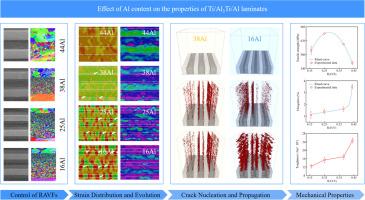Al含量对Ti/Al3Ti/Al层压板性能的影响
IF 9.4
1区 工程技术
Q1 ENGINEERING, MECHANICAL
International Journal of Mechanical Sciences
Pub Date : 2025-09-17
DOI:10.1016/j.ijmecsci.2025.110852
引用次数: 0
摘要
残余铝体积分数(RAVFs)及其对Ti/Al3Ti/Al层合金属复合材料(lmc)力学性能、局部应变分布和微裂纹形成模式的影响之间的基本关系尚不清楚,这阻碍了高性能lmc的设计进展。本研究通过调整热压温度,设计了一系列具有不同ravf的Ti/Al3Ti/Al lmc。通过高分辨率数字图像相关(HR-DIC)和原位x射线微计算机断层扫描(μCT)相结合,阐明了RAVFs影响lmc力学性能、应变发展、裂纹萌生和扩展的机理。研究表明,拉伸强度先升高后降低,在25%的ravf下达到峰值641 MPa。然而,随着ravf浓度的降低,伸长率呈现出从3.5%到1.1%的单调下降。此外,随着RAVFs的减小,Al3Ti的纵向应变局部化更加强烈,各层内横向应变的均匀性变差。这使得lmc的断裂模式从主要的界面分层转变为主要的金属间相断裂。该研究为优化lmc的力学性能提供了新的视角,有望为高性能复合材料的开发提供理论支持和实践指导。本文章由计算机程序翻译,如有差异,请以英文原文为准。

Effect of Al content on the properties of Ti/Al3Ti/Al laminates
The fundamental relationship between residual aluminum volume fractions (RAVFs) and their effects on mechanical properties, local strain distribution, and microcrack formation patterns in Ti/Al3Ti/Al laminated metal composites (LMCs) remains unclear, which impedes progress in designing high-performance LMCs. This study designed a series of Ti/Al3Ti/Al LMCs with different RAVFs by adjusting the hot-pressing temperature. By combining high-resolution digital image correlation (HR-DIC) with in-situ X-ray micro-computed tomography (μCT), the mechanism by which RAVFs affect the mechanical properties, strain development, and crack initiation and propagation of LMCs has been clarified. The study revealed that the tensile strength initially increases and then decreases, culminating in a peak of 641 MPa at 25 % of RAVFs. However, the elongation exhibits a monotonic decrease from 3.5 % to 1.1 % as the concentration of RAVFs declines. In addition, it was found that as RAVFs decrease, the longitudinal strain localization in Al3Ti becomes more intense and the uniformity of transverse strain within each layer worsens. This causes the fracture mode of LMCs to shift from mainly interface delamination to primarily fracture of the intermetallic phase. This study offers a novel perspective for optimizing the mechanical properties of LMCs, promising to provide theoretical support and practical guidance for developing high-performance composites.
求助全文
通过发布文献求助,成功后即可免费获取论文全文。
去求助
来源期刊

International Journal of Mechanical Sciences
工程技术-工程:机械
CiteScore
12.80
自引率
17.80%
发文量
769
审稿时长
19 days
期刊介绍:
The International Journal of Mechanical Sciences (IJMS) serves as a global platform for the publication and dissemination of original research that contributes to a deeper scientific understanding of the fundamental disciplines within mechanical, civil, and material engineering.
The primary focus of IJMS is to showcase innovative and ground-breaking work that utilizes analytical and computational modeling techniques, such as Finite Element Method (FEM), Boundary Element Method (BEM), and mesh-free methods, among others. These modeling methods are applied to diverse fields including rigid-body mechanics (e.g., dynamics, vibration, stability), structural mechanics, metal forming, advanced materials (e.g., metals, composites, cellular, smart) behavior and applications, impact mechanics, strain localization, and other nonlinear effects (e.g., large deflections, plasticity, fracture).
Additionally, IJMS covers the realms of fluid mechanics (both external and internal flows), tribology, thermodynamics, and materials processing. These subjects collectively form the core of the journal's content.
In summary, IJMS provides a prestigious platform for researchers to present their original contributions, shedding light on analytical and computational modeling methods in various areas of mechanical engineering, as well as exploring the behavior and application of advanced materials, fluid mechanics, thermodynamics, and materials processing.
 求助内容:
求助内容: 应助结果提醒方式:
应助结果提醒方式:


